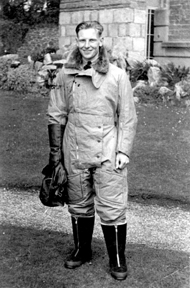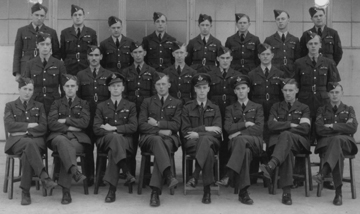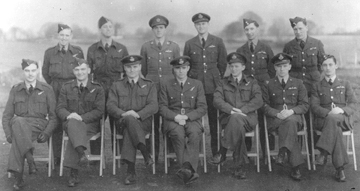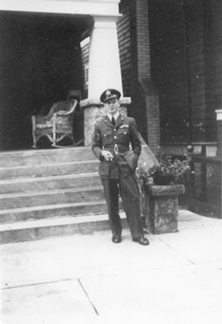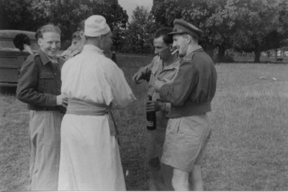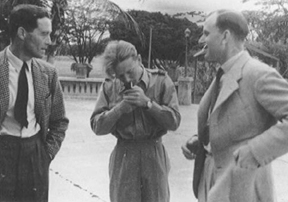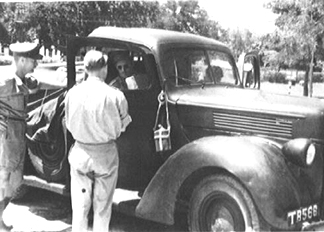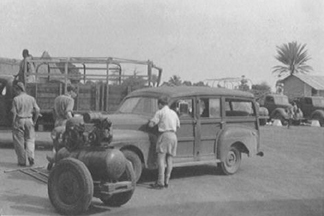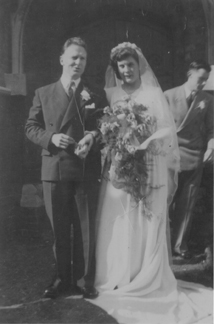 |
 |
||||||||||
|
Squadron Leader EL Wood 128581 (formerly 1338421) RAFVR 1922—1995 Born in 1922, Eric Leslie Wood was studying engineering at Chiswick Technical College (now Brunel University) when he enlisted in the RAF Volunteer Reserve in March 1941. Pilot under training
In the third week of March 1942 LAC Wood was in Manchester at the Aircrew Despatch Centre, Heaton Park, awaiting embarkation to Canada. Many, many thousands of airmen took part in that vast aircrew training scheme, known in the UK, Australia and elsewhere as the Empire Air Training Scheme (EATS) and in Canada as the British Commonwealth Air Training Plan (BCATP). Over 49,000 war-time pilots qualified through the Canadian BCATP schools alone. Flying the Avro Ansons and Cessna Cranes of 33 Service Flying Training School at Carberry, Manitoba from April to August 1942, he achieved his pilot’s wings to be commissioned a Pilot Officer on Probation on 14 August. From there, Wood went on to 31 General Reconnaissance School at Charlottetown, Prince Edward Island, flying more Ansons before returning to England that November for the “final polish”.
EL Wood in the front row, third from the left. By December 1942 EL Wood (then known as Les) found himself posted to 9 (Coastal) Operational Training Unit at Crosby-on-Eden, crewing up with his navigator, Pilot Officer Leonard Robert Stokell (known as Bob). Together they passed through their OTU course, Wood gaining promotion to Flying Officer in the process. “Les” through his early RAF years, in India Wood came to prefer “Fred”, and so he remained, in service and on “civvy street”.
EL Wood is in the front row, second from the right, with certainty. After that, there is clearly some confusion over naming. LR Stokell is third from the right next to Wood according to his caption: Front row: P/O Yeates, P/O Kilsby, P/O Wroath, P/O Wiles, P/O Stokell, [F/O Wood], P/O Knowles. Back row Sgt Simpson, Sgt Shaw, P/O Garmany, Lt Hounsom, Sgt Helps, Sgt Jones. Others recall that it is Kilsby third from the right (next to Wood), and Stokell second from the left. Further, the only identifiable Lieutenant in the back row is third from the left: Lt Hounsom with the pips of a South African Air Force Lieutenant and identified by his family, not fourth from the left as named by Wood. Personal photographs are not necessarily easy to identify after the event. Perhaps Wood intended that the captions be read from right to left. Moving on to 304 Ferry Training Unit at Port Ellen, on the island of Islay in the west of Scotland, the pair found themselves slated for posting to a Beaufighter Squadron about to form in India: No 177 Squadron RAF, one of that theatre’s heavy strike fighter units. Wood and Stokell were to ferry Beaufighter Mark VIC JL518 out to their new Squadron. On 30 April 1943 they took off from Port Ellen, flying south to Portreath in Cornwall, there to make the final preparations for their long ferry flight. Aged 21, Wood now had 342 hours in his log book, with just 55 flying hours as first pilot. The ferry flight to India alone would add 34 hours flying time to his account. Solo to India
Repaired, they set off again on 5 May 1943 to reach Gibraltar in 6 hours for a well-earned rest. The next day, the leg was almost as long, then onwards, onwards, in the air for four hours day after day, to arrive at Karachi on 16 May. There the pace slackened, perhaps as a sign of things to come: Wood took JL518 for inspection at the Maintenance Unit on 18 May 1943 and there she languished for the next ten days. It turned out that preparations for 177 Squadron were, as Sutherland Brown has aptly remarked, lengthy and erratic. On arrival in early June 1943, the pair found the Squadron in an uncertain stage of working up, with many more aircrew than needed. Wood flew very little with the Squadron in June and July, and then not with Bob Stokell. Attached to 308 Maintenance Unit, Allahabad in June and July, his log continued to be signed by 177 Squadron staff until August 1943. Thereafter, until April 1944, the two found themselves kicking their heels in various postings, battling to keep both busy and current. For a period with ATP Poona and AHQ India at Delhi, Wood appears to have had had no flying at all. By November 1943, things were looking up. At AHQ India Communications Flight Delhi, he was to fly a variety of aircraft, ranging from the familiar and pedestrian Avro Anson to the Fairchild Argus, and from the unloved Bristol Bisley to the Vega Gull. With the New Year came duty at 21 Ferry Control Mauripur outside Karachi, where Wood and Stokell found themselves crewed together a number of times on ferry jobs with various Marks of Beaufighter, giving them valuable familiarity with the quirks of a powerful aircraft. 211 Squadron Arriving late in June, by 3 July they were in the air together on a local flight and air test, feeling out the ground. Three days later they were off on an offensive sweep, in Beaufighter X NE288 ‘K’. On this 6 July sortie, the first of many operations together with 211 Squadron over Burma, the pair returned safely to report “no movement seen”. Both men rose to Flight Lieutenant in the course of their duties. Wood, promoted in August 1944, thereafter acting as Flight commander at various periods in both ‘A’ Flight (November 1944) and ‘B’ Flight (March 1945). By April 1945, mostly flying together, Wood and Stokell had each completed a tour of operations with 211 Squadron. From July 1944 to April 1945, F/Lt Wood had accumulated some 240 operational flying hours in the course of 54 operations over Burma, out of a total of 808 hours 45 minutes flying time on 11 aircraft types. In May 1945, the Squadron stood down from operational status, to convert to the de Havilland Mosquito. East Africa and Tabora
This undated photograph has proved intriguing. Wood named and dated a number of his earlier photos, but not those overseas. There are five RAF men in shot, two obscured. Three of them (including EL Wood) are holding beer bottles. The object to the left, leaning on the ute, is a large brush. Local commentators feel confident that the gowned man is a servant, despite his rather European appearance, and other contemporary Tabora photographs show similar features and dress. In East Africa, Wood was a Squadron Leader, yet in this shot he looks very young. Despite that and the absence of the usual rings on his shoulder tabs, the weight of evidence points to this photograph as at Nairobi (Kenya) or Tabora (Tanganyika).
Again undated, this photograph has also proved troublesome. In a stylish setting, the tweed jackets of Wood’s companions suggest a relaxed but semi-formal occasion on a cool day. Straining to interpret the rather soft print, I found it difficult to see Wood’s shoulder tabs as more than the two rings of a Flight Lieutenant. Checking other photographs reminded me that the thin “scraper” ring of some ranks in RAF uniform lace can be hard to properly distinguish from a full ring. So the two-and-a-half rings of the Squadron Leader can be difficult to tell from the Flight Lieutenant’s two, just as is the thin ring of the Pilot Officer vs the full ring of the Flying Officer. Enough excuses: on balance, this must be S/Ldr Wood and probably at Tabora (or rather less likely, Nairobi) in 1945.
Hatless and back to camera in the midday sun, Wood and another hatted officer in conversation with an MT Driver. Wood’s shoulder tabs are all but invisible in this shot, and the sign on the striped-post seen above the ute’s bonnet is not readable. The ute is a 1940s Ford commercial pickup truck. A standard British Army 1937-pattern water bottle and carrier hangs from mirror arm. The civil registration number implies a requisitioned vehicle or a place where British military vehicles used civil numbers. The license plate turned out to be the clue. Thanks to Elizabeth Kaegi’s persistence, it turns out that vehicle license plates in Tanganyika were of the form shown here, which is fairly certainly TB568: a “Tabora” number, perhaps.
Again, no notation on Wood’s print. Difficult to be certain, but the buildings are less reminiscent of the attap common to Burma than the tin sheds of East Africa. The tropical palm tree is notable. There is a variety of vehicles here, none with number plates visible. Behind the RAF compressor trolley is a Ford model C11 commercial-pattern station wagon. Many of these were supplied to UK and Commonwealth forces from Canada. That may be Wood, again, back to camera, at the side of the vehicle. The trucks in the background appear to be commercial-pattern Ford 3 ton 4x2s. None of these details place the scene securely. Arguing on negative evidence is risky, but it seems that Fred did not write on the back if his later photos. Probably, then, at Tabora, where he spent a thoroughly enjoyable year with much responsibility. The homeward leg
In March 1951, Fred Wood married Trudy, née Gertrude Jordan. It is thanks to Trudy and her family, and to the tireless collecting of Elizabeth Kaegi in Canada, that so much of his story can be told here. Fred was not one for sitting back and watching life go by. After the war, he kept up a connection with the RAF Volunteer Reserve until 1953, when he at last relinquished his commission. Also keeping up the connection with things mechanical, he worked his way up through various firms in engineering and sales positions, to end his career a Company director. When in retirement he at last found time a little heavy on his hands, Fred soon re-arranged things to his liking. Returning to the old mechanical bent, he took on a job in a local car workshop. There he continued to tinker until 2 days before his death in 1995 at the age of 73. Bob Stokell died, aged 83, in 2000. Of his war time experiences, EL “Fred” Wood left his family not only his Log Book and photographs, but an abiding awareness of his long-held affection for the de Havilland Tiger Moth, an aircraft first encountered in his RAF training. Engraved on his head stone is an image of T6818, a Mark II and now of the Shuttleworth Collection. Sources Halley RAF Aircraft T1000—V9999 (Air Britain 1997) www.211squadron.org © D Clark & others 1998—2025 |
||||||||||
